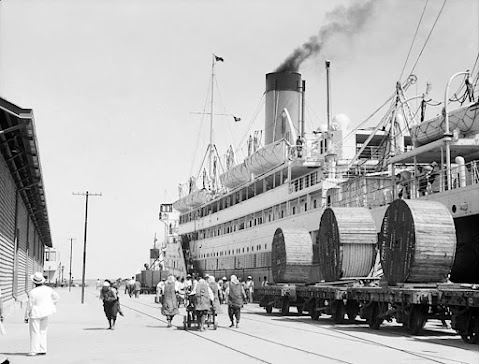Sunday, December 31, 2023
Saturday, December 30, 2023
Ship in Haifa, Palestine (now Israel), 1933
The ship, clearly for passengers, isn't named. The drums on those flat cars will be for cables.
It gives an indication of the size of ships and quantity of trade and transport that was envisioned by the British harbour development at Haifa. (Pic from Motacilla)
Friday, December 29, 2023
Thursday, December 28, 2023
driver's seat view of a run on the Normanton to Croydon railway, Australia
Wednesday, December 27, 2023
an NZR Fiat railcar on the West Coast side of the Otira tunnel, late 1950s
For lots more see our books and earlier posts, The Otira tunnel had its 100th anniversary this year.
an NSW Class Z20 steamer on the Carlingford branch line
an NSB El 9 on the Flåmsbana, Norway
Three of these Bo-Bo type were built in 1944. See earlier posts and here
on the Flåmsbana, Norway, in NSB days with an El 11 class
from Wikipedia
The NSB El 11 was an electric locomotive which was operated for both passenger and freight trains by NSB. It was the third type of Norwegian electric locomotive with bogies [trucks], after the NSB El 7 and NSB El 9. They were manufactured by Norsk Elektrisk & Brown Boveri (NEBB) and Thune mekaniske verksted.Between 1982 and 1983 three El 11s were upgraded for use on the steep Flåmsbana branch line. They have since been replaced by multiple units such as the NSB BM69 and, later, by locomotives such as the NSB El 17. The El 11s was withdrawn from service during the 1990s, with the last use in 1998. There are four preserved engines, two by the Norwegian Railway Club for use on special trains, and two by the Norwegian Railway Museum in Hamar.
Tuesday, December 26, 2023
Gaza gare (railway station), 1935
Gaza has been in the news recently, which isn't unusual. The 1948 map of Palestine, before the state of Israel was created in some of what had been Palestine, shows there was a line through Gaza into Egypt, but the station was, as this postcard says, small.
Invercargill NZ tram to Georgetown
The Georgetown line was closed in 1951; this was the year before the city's other two lines closed. See earlier posts for more.
Monday, December 25, 2023
Happy Christmas to our readers
Another year has almost passed and for transport history development, pushers of electric cars and trucks have become ever more agressive and successful despite the problems with the technology and that there are shortages of electric grid power looming in the near future because of them.
We're nostalgic for the old days when propulsion was simpler and more sensible. We're also fans of traditional paper and cardboard books without batteries, as will be apparent from the constant messages to that effect.
Keep on truckin' --transpress blog editors.
Sunday, December 24, 2023
Steam to Mombassa
SS 'Fürst Bismarck' of HAPAG (1890)
Six days from Hamburg to New York may actually have been fast in 1891 when the poster was printed.
Saturday, December 23, 2023
Friday, December 22, 2023
Thursday, December 21, 2023
Wednesday, December 20, 2023
Italian FS Class 741 2-8-0 locomotive
A total 81 of these were built between 1964 and 1950, rebuilds from the FS Class 740 with a Franco-Crosti boiler; it was the last class of steam locomotives introduced in Italy. This example was seen in 1971 probably on the Pustertal line. Two are preserved.
Tuesday, December 19, 2023
Monday, December 18, 2023
London's Baker Street Underground station hasn't changed much
Sunday, December 17, 2023
coastal ship 'Regina' from 1911
EMD's F2 units: a transitory model of which none were preserved
from American Rails
The F2's brief catalog saw sales reach only slightly more than 100 units (A's and B's), among a handful of railroads.
old 2-axle tank cars, Spain
Along to the left is what seems to be a crew car then a caboose -- none look to have been used for many years.

















































